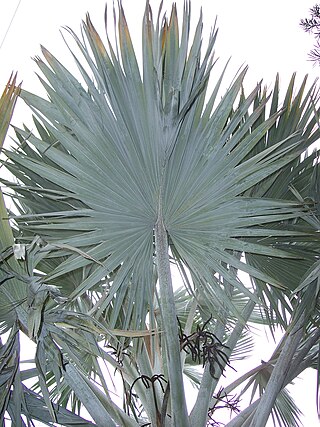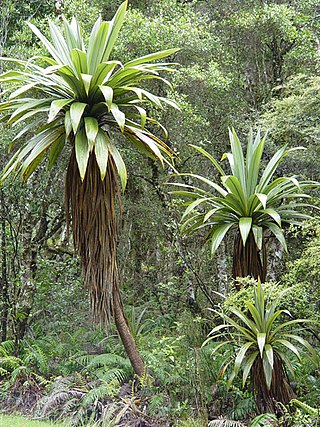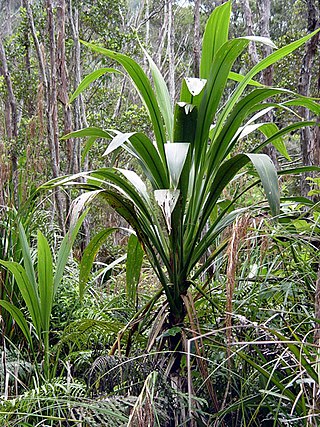Cabbage tree is a common name for several plant species:

The Arecaceae is a family of perennial flowering plants in the monocot order Arecales. Their growth form can be climbers, shrubs, tree-like and stemless plants, all commonly known as palms. Those having a tree-like form are called palm trees. Currently, 181 genera with around 2,600 species are known, most of which are restricted to tropical and subtropical climates. Most palms are distinguished by their large, compound, evergreen leaves, known as fronds, arranged at the top of an unbranched stem. However, palms exhibit an enormous diversity in physical characteristics and inhabit nearly every type of habitat within their range, from rainforests to deserts.
TI, ti, and variants may refer to:
Manx is an adjective describing things or people related to the Isle of Man:

Cordyline australis, commonly known as the cabbage tree, tī kōuka or cabbage-palm, is a widely branched monocot tree endemic to New Zealand.

Rhopalostylis is a genus of two species of palms native to the South Pacific. Both are smooth-trunked, with regular ringed scars from fallen leaves. The leaves are 3–5 m in length, and the leaf bases encircle the trunk.

Cordyline fruticosa is an evergreen flowering plant in the family Asparagaceae. The plant is of great cultural importance to the traditional animistic religions of Austronesian and Papuan peoples of the Pacific Islands, New Zealand, Island Southeast Asia, and Papua New Guinea. It is also cultivated for food, traditional medicine, and as an ornamental for its variously colored leaves. It is identified by a wide variety of common names, including ti plant, palm lily, cabbage palm.

Cordyline is a genus of about 24 species of woody monocotyledonous flowering plants in family Asparagaceae, subfamily Lomandroideae. The subfamily has previously been treated as a separate family Laxmanniaceae, or Lomandraceae. Other authors have placed the genus in the Agavaceae. Cordyline is native to the western Pacific Ocean region, from New Zealand, eastern Australia, southeastern Asia and Polynesia, with one species found in southeastern South America.
Cabbage palm is a common name for several species of palms or palm-like plants:

Fan palm as a descriptive term can refer to any of several different kinds of palms (Arecaceae) in various genera with leaves that are palmately lobed. Most are members of the subfamily Coryphoideae, though a few genera in subfamily Calamoideae also have palmate leaves. Fan palm genera include:

Cordyline indivisa is a monocot tree endemic to New Zealand, where it is called mountain cabbage tree or bush flax. It is also known as the broad-leaved cabbage tree, and in the Māori language as tōī.

Livistona australis, the cabbage-tree palm, is an Australian plant species in the family Arecaceae. It is a tall, slender palm growing up to about 25 m in height and 0.35 m diameter. It is crowned with dark, glossy green leaves on petioles 2 m long. It has leaves plaited like a fan; the cabbage of these is small but sweet. In summer it bears flower spikes with sprigs of cream-white flowers. The trees accumulate dead fronds or leaves, which when the plant is in cultivation are often removed by an arborist.

Cordyline obtecta is a widely branching monocot tree native to Norfolk Island, and to northern New Zealand. The species name obtecta derives from the Latin obtegere, alluding to the way the inflorescence barely protruded beyond the leaves in the plant first described.

Sabal palmetto, also known as cabbage palm, cabbage palmetto, sabal palm, blue palmetto, Carolina palmetto, common palmetto, Garfield's tree, and swamp cabbage, is one of 15 species of palmetto palm. It is native to the Southern United States, the Yucatán Peninsula in Mexico, and the West Indies.

Cordyline banksii is a monocot tree endemic to New Zealand. The specific epithet banksii refers to the 18th-century botanist Joseph Banks.

Diploglottis australis, known as the native tamarind, is a well known rainforest tree of eastern Australia. It is easily identified by the large sausage shaped leaflets.
C. australis may refer to:

Cordyline pumilio, commonly known as the dwarf cabbage tree, pygmy cabbage tree or by its Māori names tī koraha or tī rauriki, is a narrow-leaved monocot shrub endemic to New Zealand. It usually grows up to 1 metre tall, although rare examples of 2 metres tall have been reported. It has long leaves and can easily be mistaken for a grass or a sedge. C. pumilio grows in the north of the North Island from North Cape at 34°S to Kawhia and Opotiki at about 38°S, generally under light forest and scrub. It was cultivated by Māori as a source of carbohydrate and used as a relish to sweeten less palatable foods.
Balanococcus cordylinidis, the cabbage tree mealybug, is a species of insect in the family Pseudococcidae.